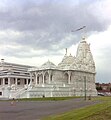Jain temple
| Part of a series on |
| Jainism |
|---|
 |
A Jain temple is the place of worship for Jains, the followers of Jainism,[1] Derasar is a word used for a Jain temple across India including Rajasthan. Basadi is a Jain shrine or temple.[2] The word is generally used in South India, including Maharashtra. Its historical use in North is preserved in the names of the Vimala Vasahi and Luna Vasahi temples of Mount Abu. The Sanskrit word is vasati, it implies an institution including residences of scholars attached to the shrine.[3]
In other parts of India, the term Jain mandir is used for all Jain temples.[citation needed]
Jain Temple Architecture
Jain temples are built with various architectural designs. Jain temples in North India are completely different from the Jain temples in South India, which in turn are quite different from Jain temples in West India. All Jain temples have many marble pillars which are carved beautifully with Demi god posture. There is always a main deity also known as mulnayak in each derasar. The main part of Jain temple is called "Gambhara" (Garbha Graha) in which there is the stone carved God idol. The main deity of a Jain temple is known as a mulanayak. A Manastambha (column of honor) is a pillar that is often constructed in front of Jain temples.
Etiquette
There are some guidelines to follow when one is visiting a Jain temple:
- Before entering the temple, one should bathe and wear fresh washed clothes - wearing which one has neither eaten anything nor visited the washroom. However, drinking of water is permitted.
- Leather items like belt, purse etc. are not allowed inside the temple premises.
- One should not take any footwear inside temple.
- One should preferably wash the feet before entering the temple.
- A separate pair of clothes, kept only for the purpose of doing pooja, has to be worn before entering the main worship area (called as Gabhara) where the idols are kept.
- A cloth has to be worn around the mouth such that nostrils are sealed before one can touch the idols.
- One should not be chewing any eatables (food, gum, mints, etc.), and no eatables should be stuck in the mouth.
- If one takes food inside derasar, one should not bring that food back outside Derasar. It should be left inside the derasar only.
- Anyone who is hurt and is still bleeding should not enter the temple.
- One should try to keep as much as silence possible inside temple.
- Mobile phones should not be used in the temple. One should keep them switched off
- you should not enter the temple with negative thoughts and anger.
Photo Gallery
-
Ellora Jain cave basadi
-
The Jain Centre, Oxford Street, Leicester
-
Karandai Jain Temple, Tamil Nadu
-
Thirupanamur Jain Temple, Tamil Nadu
-
Jain Temple of Bhodesar, Nagarparkar, Pakistan
-
Calcutta Jain Temple, c. 1905
-
Mel Sithamur Jain Math, the primary religious center of the Tamil Jains
-
Jain temple in Rajasthan
See also
Notes
- ^ Babb, Lawrence, A (1996). Absent lord: ascetics and kings in a Jain ritual culture. Published University of California Press. p. 66.
{{cite book}}: CS1 maint: multiple names: authors list (link) - ^ "Basadi". Retrieved 2007-01-26.
- ^ "Architecture of the Indian Subcontinent - Glossary". Retrieved 2007-01-08.
External links
- 2 idols stolen from Basadi
- Jain basadi to be renovated
- Basadi at Moodabidri
- Mysore basadi
- History
- Jaim basadi
- An ancient site connected with Jainism
- Touch of wonder to pilgrimage
- The Jain Legacy In Karnataka
- Karnataka’s hotbed of Jain religion
- Derasar and Dargah coexist in Gandhi's Gujarat
- Jaina Architecture in India, Comprehensive study of Jain architecture with high quality photos.
- Photos of Mulnayak in Jain Temples


















